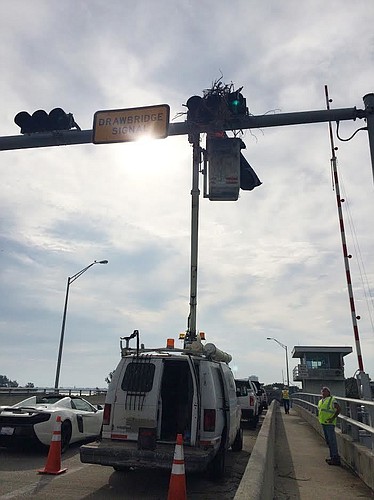- April 27, 2024
-
-
Loading

Loading

At least one osprey on Longboat Key should get points for domestic persistence.
Built on a support bar for the drawbridge signal on the New Pass Bridge, an osprey nest was removed by a work crew connected with Florida Department of Transportation on Tuesday. By Friday, the bird was back at it, returning to its original homesite with a fresh batch of twigs and other nest necessities.
A spokeswoman for FDOT said the nest removed Tuesday was abandoned and obscuring a portion of the signal that indicates the drawbridge is getting ready to open.
Susan Gilmore-Clarke, a Longboat Key resident who wrote a letter to the Longboat Observer wondering why we can’t just co-exist with local birds, had another take after seeing the bucket-truck crew at work that morning.
“Later in the afternoon, I was headed to (St. Armands) Circle, and I saw her off to the side, mournfully looking for her nest,’’ she said of the seabird. “It’s heartbreaking. There has to be a way.”
According to Robin Stublen, FDOT has a districtwide permit to remove osprey nests from department-owned poles at any time, but if ospreys are actively nesting, a wildlife biologist accompanies FDOT during the removal. This biologist advises FDOT on how to safely relocate active nests, Stublen explained.
Stublen couldn’t say how many times nests have been removed from the New Pass Bridge.
Only in Monroe County are ospreys protected as a species of special concern.
The Florida Fish and Wildlife Conservation Commission says ospreys typically nest between December and February, frequently on such man-made locations as utility poles, channel markers and platforms built specifically for their nesting. They are known to reuse nests from year to year, the FWC said. According to Cornell University's All About Birds publication, if left undisturbed, an osprey nest can be enlarged and expanded from year to year, growing from an original size of about 2.5 feet in diameter to something large enough for a human to sit in.
According to Save our Seabirds, Inc., on Longboat Key, ospreys need to be near the water in order to hunt, and they prefer to be as high as possible - preferably above all surrounding trees and structures - to reduce vulnerability to eagles and other potential predators.
Gilmore-Clarke said she has seen a nest in the same drawbridge location previously. Last year for sure, possibly longer. Experts from Save our Seabirds say they think the same birds have returned to that bridge site for possibly four nesting seasons.
And another nest is either under construction or occupied just a few hundred yards north of the bridge.
Ospreys are migratory but become less so in coastal areas of South Florida, according to the state FWC. So here, much like the human population, there are a mix of full-time residents and those from “up north.’’
Gilmore-Clarke wonders why we can’t all just get along.
“You build a nest, come back home after a while, and find it’s not there anymore,’’ said Gilmore-Clarke. “Just let it be.’’